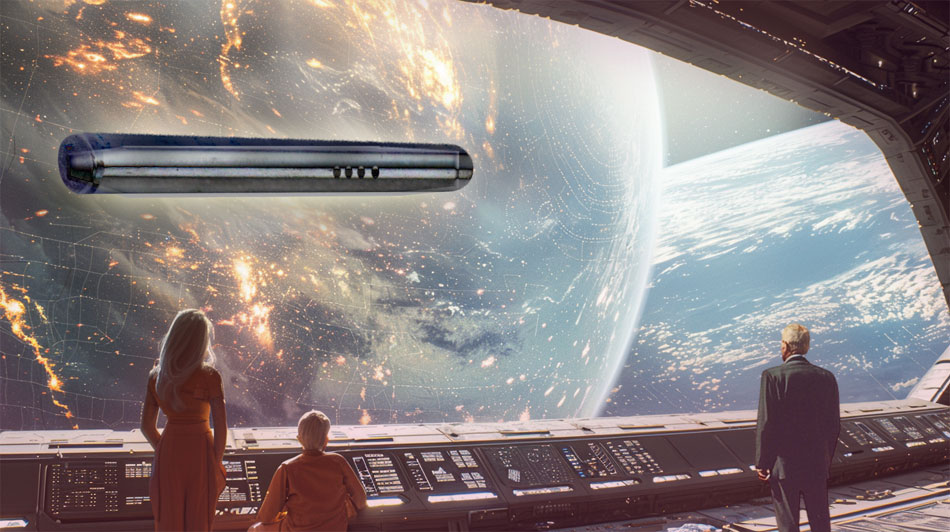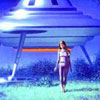Inside The Spaceships: The Mothership
 by George Adamski
by George Adamski
Our little craft glided down toward the top of the mother ship, very much like an aircraft coming in to land on the deck of an aircraft carrier. As I watched, a curved hatch or opening appeared, reminding me of a great gaping whale. Those who have seen the photographs of this ship will recall that it has a blunt nose sloping slightly downward. This hatch was situated at the far end of the main cylindrical body just before the slope of the nose became perceptible. As we touched down, the Scout moved forward into the hatch, tilting downward as it began its journey into the interior of this mighty ship. Here for the first time I had a feeling of dropping in the pit of my stomach. I imagine this was due to the fact that the Saucer was no longer using its own power but was now subject to the gravity of the mother ship.
We traveled on down at not too steep an angle, the flange of the Scout running on two rails slowly and smoothly, its rate of descent controlled by friction and the magnetism in the flange. Orthon had complete control over this, I found, for once I nearly lost my balance and he stopped the craft momentarily while I regained it. Then the slow, smooth glide continued until we had reached what I judged to be the halfway position between the top and the bottom of the mother ship. Here the Scout stopped, and the door instantly slid open.
I saw a man standing outside on a platform about fifteen feet long and six feet wide. He was holding something that looked like a metal clamp attached to a cable. He was not very tall — I should guess about five feet, five inches — and I noticed that he was of a darker complexion than any of the space people I had seen. He was dressed in a brown flying suit similar in color and style to the one worn by Orthon at our first meeting. Black hair showed from under a dark, beret-type cap.
I followed Firkon out of the Scout and Ramu came after me. Orthon was the last to leave. The man in the beret smiled and nodded to each of us as we stepped off the platform, but no words were exchanged.
From this platform a flight of about a dozen steps led down to one of the decks of the huge craft. As I was guided down them, I had time to notice that our Scout had stopped just before reaching a junction in the rails down which we had come. One pair of rails continued through the ship, curving downward out of sight. Between them was a dark space which prevented any view of what lay below. The other pair of rails continued straight on from the junction before which the craft was halted, and ran astern to a huge hangar or storage deck in which I could see several identical Scout ships lined up on the rails.
“This is the storage hangar in which the small craft are carried during interplanetary flight,” explained Firkon, stopping momentarily on the step beside me. “Had we been going on to another planet, our Scout would have stopped at the platform only long enough to let us out. Then it would have passed over the junction and been switched to its place in this large hangar. But because we shall be returning to Earth later, the Scout must be recharged at this platform.”
I glanced back and saw that the man on the platform had already slipped the clamp attached to the cable over the flange of the Scout so that it contacted both the flange and the rail beneath.
I have no idea how this recharging operation was performed; to me the clamp looked much like a machinist’s large clamp used on Earth. Nor could I see to what the other end of the cable was connected. Perhaps contact between clamp and rail was necessary to complete the circuit or for all I know, it may even have fitted into an unseen connection directly below the rim of the Scout. I did not wish to cause further delay by asking.
Although not answering the question in my mind, Firkon did volunteer, “These smaller craft are incapable of generating their own power to any great extent and make only relatively short trips from their carriers before returning for recharge. They are used for a kind of shuttle service between the large ships and any point of contact or observation, and are always dependent on full recharging from the power plant of the Mothership.”
At the bottom of the steps we entered a large control room, rectangular in shape but with rounded corners. This room, I should say, was about thirty-five by forty-five feet, and something like forty feet in height. Except for two door openings, the walls were entirely covered with colored graphs and charts like those in the Scout, but on a larger scale and more numerous.
Extending along all four sides of the room were three tiers of platforms from which the many instruments could be observed and studied. A master telescope stood on the top platform, and another on the bottom platform. From both of these were electronic extensions to many instruments in other parts of the ship, making it possible, I was told, for these two telescopes to be used from many locations on the ship.
Also in this room was a robot instrument which I was cautioned not to describe. I had noticed a miniature version of this robot in the Scout. There were also several pieces of machinery in this control room, none of which, so far as I could see, had any moving parts.
I would have liked to stop in this room for closer observation of all these graphs, charts, colors, machinery and instruments, and to have been permitted to ask questions concerning their operation, but this privilege was not granted. Instead, we went directly through this control room and through a second door which led into the most beautiful living room or lounge that I have ever seen. Its simplicity and splendor took my breath and I gasped as I stood momentarily in the doorway, not only marveling at the richness of its furnishings, but held in the wonderful emanation of harmony that came from it.
I do not know how long it took me to recover from this unexpected experience but eventually I was able to look about me with more interest for detail.
The ceiling, I judged, was about fifteen feet high, and the room could not have been less than forty feet square. A soft, mysterious blue-white light filled it, and yet I saw no lighting fixtures, and nowhere any inequality in brightness.
Then, as I stepped through the doorway into this luxurious lounge, my attention instantly was absorbed by two incredibly lovely young women who arose from one of the divans and came toward us as we entered.
This was indeed a tremendous surprise as, for some reason, I had never visualized women as space travelers. Their very presence and extraordinary beauty, the friendliness that was so apparent as they approached to greet us, together with the luxurious background in the out-of-this-world craft, were overwhelming.
The shorter of the two women touched my hand in the recognized greeting, then immediately turned away to walk over to another part of the room. Then the taller and seemingly younger girl leaned forward and touched my cheek lightly with her lips. The first lovely lady returned holding a small glass of colorless liquid which she held out to me.
Stirred deeply by the warm friendliness of these people, I thanked her and took the glass. The water (for that is what it proved to be) tasted like our own pure spring water. It seemed, however, a little denser, with a consistency something like a very thin oil. As I sipped it, I strove to regain my composure and to impress the images of these gracious and beautiful young women indelibly on my mind.
The one who had brought me the water was about five feet, three inches in height. Her skin was very fair and her golden hair hung in waves to just below her shoulders in a beautiful symmetry. Her eyes, too, were more golden than any other color and held an expression that was both gentle and merry. I had the feeling that she was reading my every thought. Her almost transparent skin was without blemish of any kind, exquisitely delicate, though firm and possessed of a warm radiance. Her features were finely chiseled, the ears small, the white teeth beautifully even. She looked very young. I judged that she could not be much over twenty years of age. Her hands were slender, with long, tapering fingers. I noticed that neither she nor her companion wore makeup of any kind on their faces or fingernails. The lips of both were a natural deep red. They wore no jewelry of any description. Indeed, such adornment would have served only to detract from their own natural beauty.
Both women wore draped garments of a veil-like material which fell to their ankles, and both robes were bound at the waist by a striking girdle of contrasting color, into which jewels seemed actually to be woven.
The garment of the little blonde was of a pure light blue, and her tiny sandals were golden in color. Later, I learned that she was a citizen of the planet we know as Venus. Kalna is the name I shall give her.
Ilmuth, my name for the other woman, was taller and a rich brunette in coloring. She also wore her hair in a cascade that fell to just below her shoulders, and it was a beautiful wavy black with highlights of reddish brown. Her large eyes were black, luminous, with flashes of brown. They held the same merry expression as those of her companion, and I felt that she, too, could read my innermost thoughts. In fact, this is an impression I have received from every person that I have met from worlds beyond our own. The color of this lovely brunette’s robe was a pale, rich green, and her sandals of a copper hue. Ilmuth, like Firkon, was an inhabitant of the planet Mars.
I realize that in trying to describe these ladies from other worlds than ours I am attempting the impossible. Perhaps, using my inadequate description as a stepping stone, the reader will search his own imagination for an image of perfect beauty — and then know that it must certainly fall short of the reality.
As I finished drinking from the small goblet of water, I was asked to be seated, an invitation I gladly accepted.
On the wall exactly opposite the door through which we had entered hung a portrait which I was certain must represent Deity. The emotion which the beauty of the two young women had aroused in me was momentarily forgotten as the wonderful radiance emanating from the portrait enveloped me. It showed the head and shoulders of a Being who could have been eighteen to twenty-five years of age, in whose face was embodied the perfect blended balance of male and female, and whose eyes held a wisdom and compassion beyond description.
I do not know how long I was enrapt by this beauty. There was no interruption until I myself returned to an awareness of my surroundings.
I did not need to ask who this Being was. Kalna broke the silence by saying, “That is our symbol of Ageless Life. You will find it in every one of our ships as well as in our homes. It is because we keep this symbol always before us that you will find no age amongst our people.”
On one side of the room was a long table surrounded by many chairs. I had the impression that this table was used by the ship’s company for meals, and perhaps also as a council table. I had an idea that the number of crew members ran into three figures, although I had seen only a few on this occasion. I received no verification of this latter impression, but my feeling about the table was substantiated by Firkon. I also learned that the greater part of the room was used as a lounge by the crew and their guests when crew members were not at their various posts during flight. The rest of the salon was casually strewn with divans, settees and chairs of different designs and sizes, very much in the manner of Earth. But in every case these were lower and more comfortable than ours, and more graceful in design and appearance. They were covered in a material of a deep soft nap with a brocade effect. The colors varied and were most attractive to look at — rich, warm and subdued.
Beside the chairs were low glass or crystal-topped tables with interesting decorative centerpieces. But I saw nothing the least like an ash tray. I suppose I knew instinctively that these people were not addicted to the nicotine habit and I left my cigarettes in my pocket. Once, however, through sheer force of habit, I reached for them. Observing this, the little lady from Venus smiled and said, “You may smoke if you like. I will get you a receptacle for your ashes. You see, only Earth people indulge in that odd habit!”
I thanked her and returned the package to my pocket without taking a cigarette.
To continue with my description — the whole floor was covered by a single luxurious rug which reached to the walls. Medium brown and perfectly plain, with a deep, soft nap, it was delightful to walk upon.
When we were asked to sit down, I found myself on one of the longer divans between Firkon and Ramu. Directly opposite, at a comfortable conversational distance, was another divan of the same shape and size. Here the two ladies seated themselves with Orthon between them. I still held the empty water glass in my hand, and now set it down on the low table in front of us.
The material of this goblet interested me. It was crystal-clear, without etching of any kind. It did not feel like our glass, nor like plastic. I had no idea of what material it was made, but I received the definite impression that it was unbreakable.
After noting the most outstanding features of the furnishings, I let my eyes roam around the walls. To my right, I noticed a large and beautiful door, slightly ajar, with no knob or lock that I could see. Kalna told me that this led into a storage room, adding, “Our ship often is long absent from our home planet as we travel and study space. Nor do we always stop on other planets during such trips. Consequently, large storage facilities are needed for supplies and equipment.
“The door you see over there in the opposite wall, like the one serving the supply room, leads into a kitchen.”
This door gave onto the portion of the room I supposed was used for dining purposes. I was not taken into either of these rooms.
I studied with interest a large picture near the door on the wall to my right. It showed a city which at first glance seemed little different from those on our Earth, except that it was laid out in circular form instead of the series of hard rectangles usual with us. But the architecture was very different. I hardly know how to describe it, for not one of our many architectural styles approximates it in any way. Here was perfection of the graceful lightness and delicacy for which many of our better modern architects are striving but have never quite achieved. It was the kind of city of which men dream, but never see on our Earth. I had guessed, before I was told, that the city depicted here was on Venus, this ship’s home planet.
On the other side of the door was yet another painting, a pastoral scene of hills and mountains with a stream running through the farmland. This might have passed even more easily for an earthly scene except that the farmhouses were not scattered around the countryside, but also followed a circular plan. I was told that this arrangement had been found more practical in enabling these farm groups to become small, self-sufficient communities, containing everything necessary to supply all essential commodities for the country folk. On Venus there is true equality in all respects, including allocation of commodities. Trips to the cities, then, need be undertaken only for pleasure or for personal reasons.
On the opposite wall, behind the long table, I noticed a picture of a large mother ship, and I wondered whether it represented the one we were in. But as this thought passed through my mind, the little lady from Venus corrected it by saying, “No, our mothership is really very small in comparison. That one is more like a traveling city than a ship, since its length is several miles, while ours is only two thousand feet.”
I realize that my readers are likely to consider such dimensions incredible, and I readily admit that I myself was unprepared for anything so fantastic. However, it is necessary to remember that, once we have learned to harness the great natural energies instead of depending on mechanical force, it should be no more difficult to build cities within the walls of gigantic ships than on the ground. London and Los Angeles are cities nearly forty miles wide which were built largely by crude machines and manpower — a prodigious achievement in itself. Once gravity is mastered, cities in the air for us, too, can become a reality.
“Many such ships have been built,” Kalna explained, “not only on Venus but also on Mars and Saturn and many other planets. However, they are not intended for the exclusive use of any particular planet, but for the purpose of contributing to the education and pleasure of all citizens in the whole brotherhood of the Universe. People naturally are great explorers. Therefore, travel in our worlds is not the privilege of the few, but of all. Every three months a fourth of the inhabitants of our planets embark on these gigantic ships and set out for a cruise through space, stopping at other planets just as your cruise liners stop at foreign ports. In this way our people learn about the mighty Universe and are enabled to see, firsthand, a little more of the ‘many mansions’ in the Father’s house to which your Bible refers.
“In the temples of wisdom on our planets we have many mechanical devices by means of which our citizens also can study conditions in other worlds and systems, and space itself. But with us as with you, nothing can quite take the place of actual experience. So we have built fleets of gigantic ships like the one you see pictured there, which might also be described literally as small artificial planets. They contain everything necessary for the welfare and pleasure of thousands of people over a three-month period. Apart from size, the main difference is that planets are spherical in shape, are divinely made, and move in elliptical orbits around a central Sun, while these little man-made planets are cylindrical and can move through space at will.”
An ever-increasing concept of our star-studded heavens unfolded before my mind’s eye as I contemplated the information just given me. I wondered to what “other planets” Kalna referred.
Replying to my mental question, Orthon volunteered, “Our ships have not only visited all other planets in our system, but those in systems close to ours. However, there still are planets without number in the infinite systems within the Universe which we have not yet reached.”
Here again a wondering thought slipped in as I mentally questioned what they had found on the “other planets” they had visited.
The Venusian’s eyes sparkled and a tiny smile flitted across his mouth as he caught my thought. He continued without interruption. “With the sole exception of inhabitants on Earth, we have found the peoples of other worlds to be very friendly. They, too, have gigantic space cruisers for the pleasure and education of their fellowmen. As we visit their planets and are welcomed, they also visit ours as friends. It is to the Earth alone that these passenger cruisers never approach. Nor will they be permitted to do so until your people have a greater understanding of fellowship as well as of the Universe beyond the limiting confines of your own little planet.
“During flights of this kind, those on the cruise have much leisure time, as well as definite hours devoted to learning. When they land on other planets mutually interesting social gatherings are held. In short,” and he made this very clear, “peoples of other worlds are not strangers to one another, but all are friends and are welcomed wherever they go.
“We consider planets throughout the Universe as being in one vast sea of life. The far distant planets by the billions which we have not yet visited will be explored when we have further improved our space ships. There are some planets so far out from any in our system that it would take us two or three years to reach them. Whereas, within our system, the distance between planets can be covered within a few hours to a few days.”
Reviewing our concept of distance, I exclaimed, “That is staggering to me! How fast do you travel that you can cover such vast distances in so short a time?”
“Speed to us,” was the reply, “does not mean what it does to you. For once a ship is launched into outer space, the speed of the ship is equal to the activity in space! Instead of being artificially propelled, as are your planes, ours travel on the currents of space.”
I derived some small hope for our eventual progress on Earth when they freely admitted that, in the earliest attempts to conquer space, the inhabitants of Venus and those of other worlds had been faced with exactly the same problems as those that are holding us back today. Once again they stressed that gravity must be overcome as a first principle on the way to space travel.
Excerpt from Inside The Spaceships
See Part II here.
Posted in Life On Other Worlds, Other Topics, UFOswith comments disabled.





